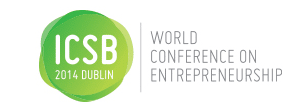W ith nearly a thousand delegates from all over the world descending on Dublin, Ireland- the storytelling capital of the world – is it any wonder that storytelling would be the order of the day! This week at the 2014 World Conference on Entrepreneurship, stories of entrepreneurial success and academic success in the classroom teaching the art and science of entrepreneurship fell on attentive ears from all parts of the globe.
ith nearly a thousand delegates from all over the world descending on Dublin, Ireland- the storytelling capital of the world – is it any wonder that storytelling would be the order of the day! This week at the 2014 World Conference on Entrepreneurship, stories of entrepreneurial success and academic success in the classroom teaching the art and science of entrepreneurship fell on attentive ears from all parts of the globe.
A New Course of Study
Entrepreneurship is a relatively new course of study and there are many different approaches to teaching it. In Europe, for instance, college professors are starting with students who have been trained to be employees. In Russia, the concept is even more foreign. Yet, no matter what the challenges of culture and history, professors of entrepreneurship are keen on sharing what they know and what has worked for them.
Measuring the success of entrepreneurship education is a subject of debate. Is it how many businesses your college grads launched? Is it how much funding your students’ business plans raised? Is it the one or two stellar successes your school has produced? Or is it, as we believe it should be, how many of your students’ start-ups are still in business three years later?
Speaking at The World Conference of Entrepreneurship
So against this background of novelty and casting about for best practices and success metrics, we were asked to give four consecutive talks. These include the one-hour keynote for the opening day; a half-hour talk to the speakers, executive committee, and past presidents; a twenty-minute address to the Women’s Entrepreneurial Forum; and finally a short fifteen-minute welcome keynote at the opening reception – all on the same day!
Having spent 20 years growing our company, starting with no money and no knowledge of our industry and building an international bestselling brand, we had a lot to share. Also, having spoken at over 25 schools of entrepreneurship in the last one-year period, we have a unique snapshot of the state of entrepreneurship education today.
But starting with a one-hour talk and condensing it all day as our allotted time slots became shorter and shorter, helped us hone in on our basic message. Some of the entertaining stories that punctuate our points had to go by the wayside. So what was our bottom line message to the entrepreneurship educators of the world?
The Biggest Fears of Entrepreneurs
The biggest fears your students face are being undercapitalized and undereducated in their chosen industry. We too had those challenges and they turned out to be our greatest assets.
With very little capital, we had to become resourceful and innovative. We didn’t have money to throw at problems. As a result, we stumbled on support for non-profits as a viable alternative to conventional paid advertising. Even when we could afford advertising, we chose to continue with what we termed Worthy Cause Marketing. It was more targeted and created customer loyalty.
Because we lacked knowledge, we put a foot on our bottle against the overwhelming tide of stuffy wine labels. This disrupted our industry by making wine fun, and allowed us access to beer drinkers. We asked everyone in the distribution channel where there was an opportunity to succeed. And because we asked we were given a key to a niche in this crowded market.
But the guiding principle to our success was “Put yourself in the other guy’s shoes!” Whether the other guy is an employee, vendor, banker, wholesaler, retailer or customer, find out what motivates them. And give it to them. In the process, you may find out that this is not what you signed up for, but is necessary for success. Our success is proof that the Golden Rule still rules!



